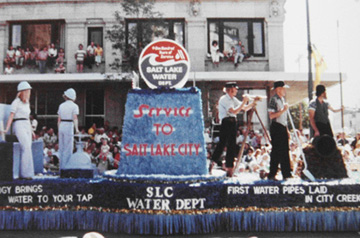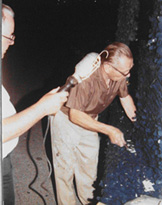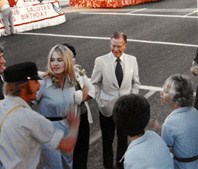The year we “floated” in the Pioneer Days of '47 Parade
In 1976, the Water Department celebrated its centennial by participating in the parade
LeRoy W. Hooton, Jr.
|
Every July 24 we celebrate this historic event by holding one of the nation's largest parades, starting downtown and ending at Liberty Park with over 150 floats, bands and other entries.
The annual celebration first began one year after the settlers first arrived in the valley. In 1848, the first parade was a simple procession of pioneers along with Brigham Young and other dignitaries traveling to the Bowery on Temple Square, where President Young spoke. Subsequently, every anniversary there have been similar parades, which grew in scope and size each year. The parade as we know it today didn't begin until 1897. The 1931 parade was described as the first large-scale parade with 100 floats, 38 bands, 500 horses and 300 marchers. It became more organized in 1943 when the “Days of '47 Committee” was formed by agreement to manage the event (Historic information from the Deseret News; Pioneer past: Days of '47 Parade is time honored tradition, by Lynn Arave, July 24, 2003).
In 1976, the Water Department celebrated its 100th anniversary by entering a float in the parade. Never doing this before, the department's employees had to learn how to build a float meeting the standards of the Days of '47 Committee. A used float trailer was found in Bountiful and the work began. This task was assigned to the maintenance division, which met the challenge by building a terrific float.
The first task was to develop a theme. It was decided to focus on early water development, which played a critical role in the settlements' survival. Also, highlighted were the first water pipes laid from City Creek and the present-day technology of delivering municipal water supply. The centerpiece of the float was the department's logo placed on a pedestal with the slogan “Service to Salt Lake City.” The theme chronology began with the early historic events located in the front of the float with the contemporary located on the rear of the float.
|
Both City (Water) Commissioner Herman J. Hogensen and Superintendent Charles W. Wilson were present at the parade site to cheer-on the float members.
Participating in the parade was a lot of fun and gave the department the opportunity to draw attention to the service it provides to the community and its contribution to the history of Utah. Thousands of people saw the float. Many lining the parade route, applauded as the float passed them.
Other events during the year included digging up a section of the first cast iron pipe installed in 1876 to check its condition. A section of 16-inch pipe was excavated one-half block east of the LDS Office Building just off Second Avenue and Canyon Road. The pipe was identified by the letters “D.L.75,” which verified that it was purchased from Dennis Long & Co. of Louisville and manufactured in 1875. The pipe section was in excellent condition. Subsequently, Salt Lake City joined the Cast Iron Institutes' “Century Club” by having pipe in service over 100 years old.
The year was a great one for the department. Besides celebrating its 100th anniversary in the parade, it was honored by the International AWWA at its annual conference held in Atlantic City, NJ where it received the “Best Public Relations Award” for large systems. This was a marvelous accomplishment competing against the likes of East Bay MUD and New York City – and winning.
|
Today, we can celebrate this state holiday, by remembering our contributions to the growth and prosperity of the Salt Lake valley by the delivery of critical municipal services to our customers; and for several hours in 1976 the Water Department participated in the celebration by having a float in one of the greatest parades in the nation – the Days of '47 Parade.
Have a Happy 24th!


